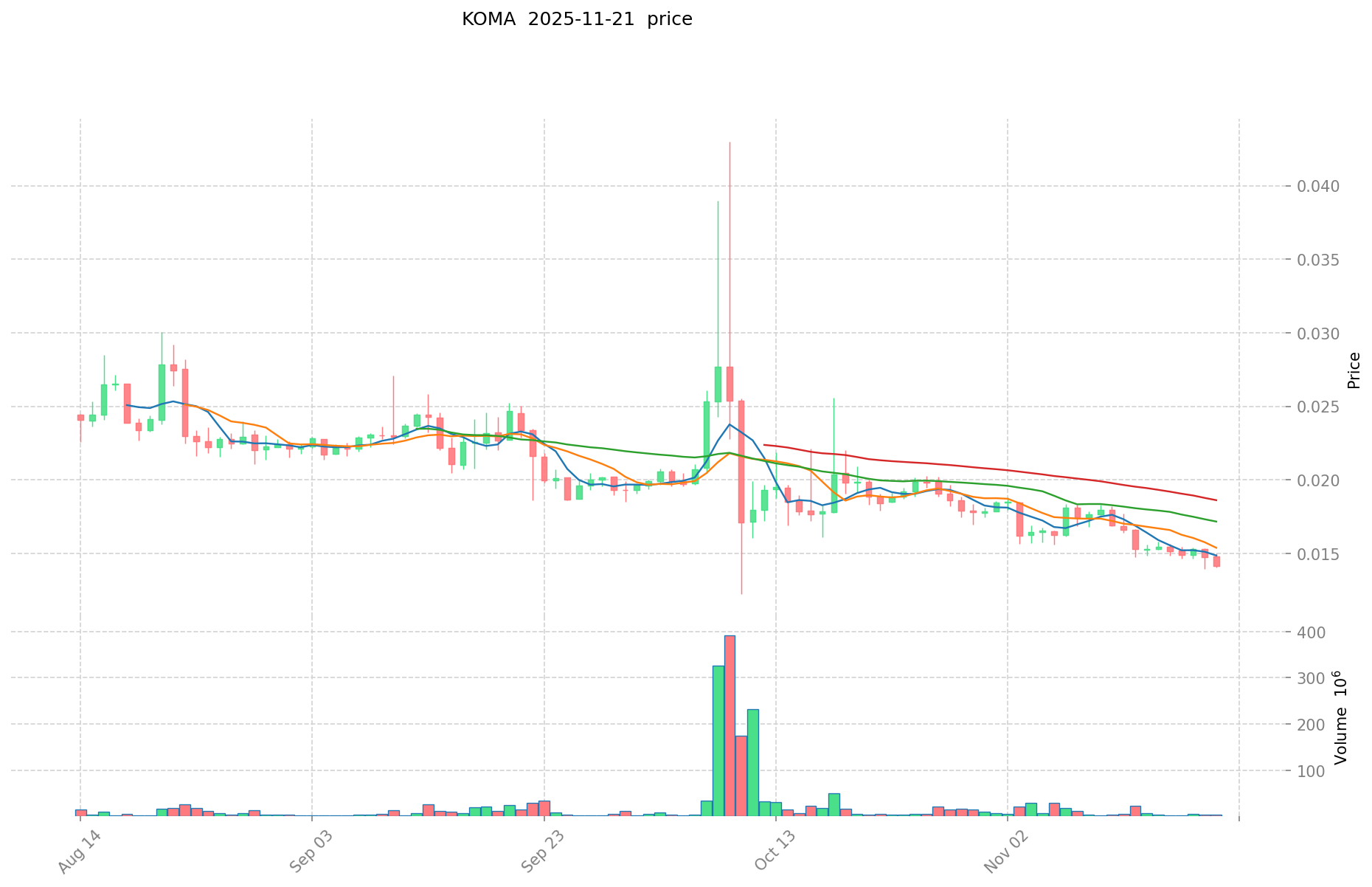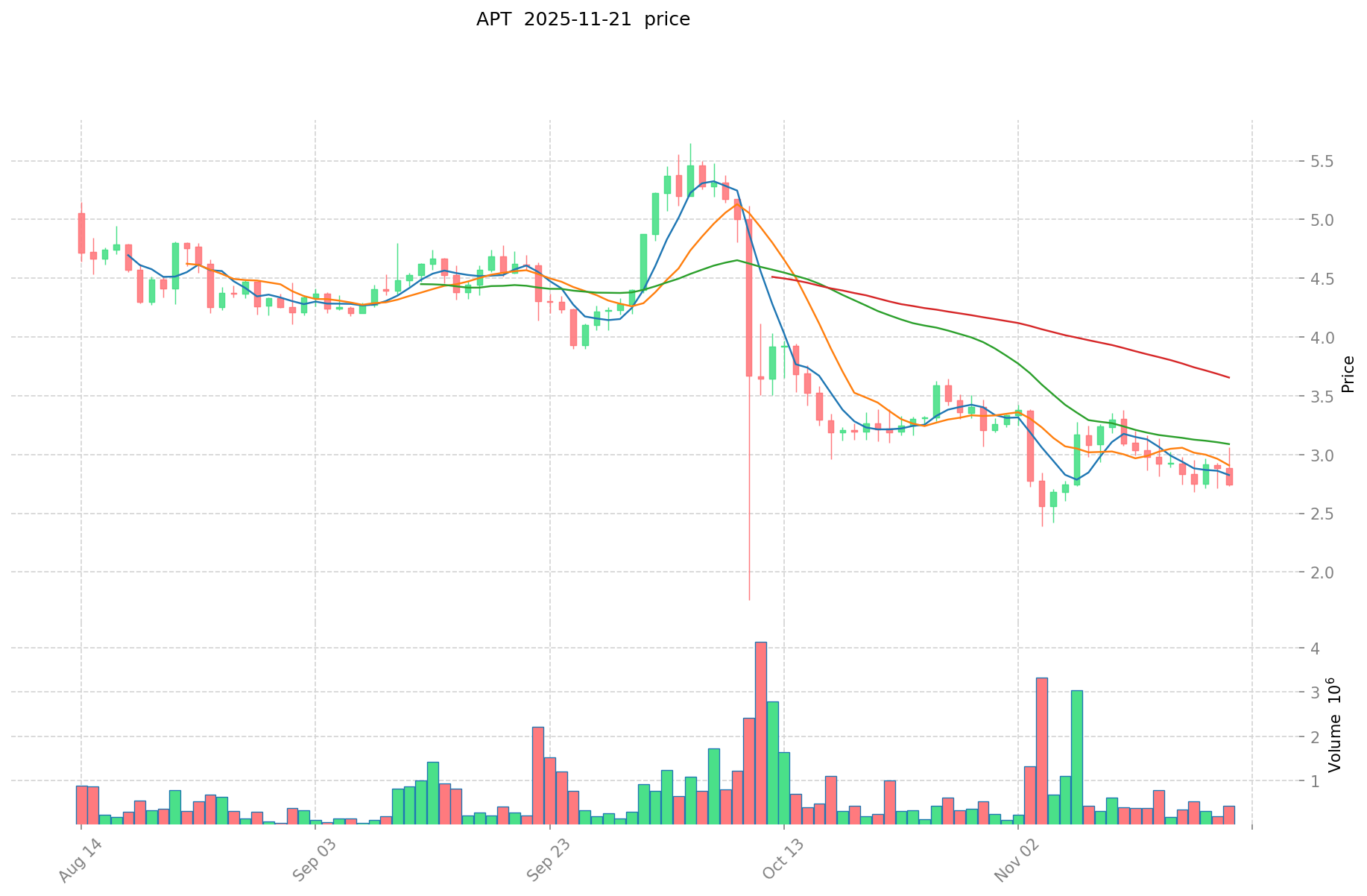KOMA vs APT: The Battle for Cybersecurity Supremacy in the Digital Age
Introduction: KOMA vs APT Investment Comparison
In the cryptocurrency market, the comparison between KOMA and APT has always been a topic that investors cannot ignore. The two not only show significant differences in market cap ranking, application scenarios, and price performance, but also represent different cryptocurrency asset positioning.
Koma Inu (KOMA): Launched as a dog-themed token, it focuses on community-driven decentralization and charity, aiming to "make BNB great again."
Aptos (APT): Introduced as an independent, high-performance PoS Layer 1 project, it aims to deliver a secure and scalable Layer 1 blockchain utilizing the Move programming language.
This article will comprehensively analyze the investment value comparison between KOMA and APT, focusing on historical price trends, supply mechanisms, institutional adoption, technological ecosystems, and future predictions, attempting to answer the question investors care about most:
"Which is the better buy right now?"
I. Price History Comparison and Current Market Status
KOMA and APT Historical Price Trends
- 2024: KOMA reached its all-time high of $0.20185 on December 25, 2024.
- 2025: APT hit its all-time low of $2.41 on November 5, 2025.
- Comparative analysis: In the recent market cycle, KOMA dropped from its peak of $0.20185 to a low of $0.0095, while APT declined from its all-time high of $19.92 to its current price near its all-time low.
Current Market Situation (2025-11-21)
- KOMA current price: $0.01337
- APT current price: $2.508
- 24-hour trading volume: KOMA $143,470.39 vs APT $2,707,257.63
- Market Sentiment Index (Fear & Greed Index): 14 (Extreme Fear)
Click to view real-time prices:
- View KOMA current price Market Price
- View APT current price Market Price


II. Core Factors Affecting Investment Value of KOMA vs APT
Supply Mechanisms Comparison (Tokenomics)
- KOMA: Fixed maximum supply of 1 billion tokens with a deflationary model; burn mechanism implemented through transaction fees
- APT: Maximum supply of 1 billion tokens with gradual release through staking rewards and ecosystem incentives
- 📌 Historical pattern: Deflationary models like KOMA's tend to create upward price pressure during adoption phases, while APT's gradual distribution supports sustainable ecosystem growth.
Institutional Adoption and Market Applications
- Institutional holdings: APT has attracted more institutional investment with backing from a16z and other major VCs, while KOMA is still emerging on this front
- Enterprise adoption: APT is being utilized in enterprise solutions for high-throughput applications, while KOMA focuses on cross-chain integration and interoperability
- Regulatory attitudes: Both projects face similar regulatory scrutiny, though APT's established foundation provides more regulatory clarity in major markets
Technical Development and Ecosystem Building
- KOMA technical upgrades: Recent implementation of cross-chain messaging protocol enhancing interoperability across major blockchain networks
- APT technical development: Layer 1 platform with Move programming language offering enhanced security and resource-oriented programming model
- Ecosystem comparison: APT has a more developed DeFi ecosystem and NFT marketplace presence, while KOMA excels in cross-chain applications and interoperability solutions
Macroeconomic and Market Cycles
- Performance in inflationary environments: Both tokens have limited historical data during inflation cycles, though APT's institutional backing may provide more stability
- Macroeconomic monetary policy: Both are affected similarly by interest rates and dollar strength, typical of the broader crypto market
- Geopolitical factors: KOMA's cross-chain capabilities may provide advantages during geopolitical tensions by enabling seamless value transfer across borders and networks III. 2025-2030 Price Prediction: KOMA vs APT
Short-term Prediction (2025)
- KOMA: Conservative $0.012087 - $0.01343 | Optimistic $0.01343 - $0.0173247
- APT: Conservative $1.85296 - $2.504 | Optimistic $2.504 - $2.6292
Mid-term Prediction (2027)
- KOMA may enter a growth phase, with expected prices ranging from $0.00979537195 to $0.0254302925625
- APT may enter a bullish market, with expected prices ranging from $1.61464806 to $4.33562905
- Key drivers: Institutional capital inflow, ETF, ecosystem development
Long-term Prediction (2030)
- KOMA: Base scenario $0.019984190908304 - $0.028962595519282 | Optimistic scenario $0.028962595519282 - $0.036492870354295
- APT: Base scenario $3.613145786597943 - $3.885102996341875 | Optimistic scenario $3.885102996341875 - $5.244889045061531
Disclaimer: The above predictions are based on historical data and current market trends. Cryptocurrency markets are highly volatile and subject to rapid changes. These projections should not be considered as financial advice or guarantees of future performance. Always conduct your own research and consult with financial professionals before making investment decisions.
KOMA:
| 年份 | 预测最高价 | 预测平均价格 | 预测最低价 | 涨跌幅 |
|---|---|---|---|---|
| 2025 | 0.0173247 | 0.01343 | 0.012087 | 0 |
| 2026 | 0.0222971575 | 0.01537735 | 0.0139933885 | 15 |
| 2027 | 0.0254302925625 | 0.01883725375 | 0.00979537195 | 40 |
| 2028 | 0.026339190055937 | 0.02213377315625 | 0.019699058109062 | 65 |
| 2029 | 0.03368870943247 | 0.024236481606093 | 0.0155113482279 | 81 |
| 2030 | 0.036492870354295 | 0.028962595519282 | 0.019984190908304 | 116 |
APT:
| 年份 | 预测最高价 | 预测平均价格 | 预测最低价 | 涨跌幅 |
|---|---|---|---|---|
| 2025 | 2.6292 | 2.504 | 1.85296 | 0 |
| 2026 | 3.413578 | 2.5666 | 2.463936 | 1 |
| 2027 | 4.33562905 | 2.990089 | 1.61464806 | 18 |
| 2028 | 3.77274479575 | 3.662859025 | 2.74714426875 | 45 |
| 2029 | 4.05240408230875 | 3.717801910375 | 2.528105299055 | 47 |
| 2030 | 5.244889045061531 | 3.885102996341875 | 3.613145786597943 | 54 |
IV. Investment Strategy Comparison: KOMA vs APT
Long-term vs Short-term Investment Strategy
- KOMA: Suitable for investors focused on cross-chain integration and community-driven projects
- APT: Suitable for investors looking for established Layer 1 platforms with institutional backing
Risk Management and Asset Allocation
- Conservative investors: KOMA: 20% vs APT: 80%
- Aggressive investors: KOMA: 40% vs APT: 60%
- Hedging tools: Stablecoin allocation, options, cross-currency portfolios
V. Potential Risk Comparison
Market Risk
- KOMA: Higher volatility due to smaller market cap and community-driven nature
- APT: Exposure to broader Layer 1 competition and market cycles
Technical Risk
- KOMA: Scalability, network stability across multiple chains
- APT: Potential vulnerabilities in Move language, ecosystem development challenges
Regulatory Risk
- Global regulatory policies may impact both, with APT potentially facing more scrutiny due to its Layer 1 status
VI. Conclusion: Which Is the Better Buy?
📌 Investment Value Summary:
- KOMA advantages: Cross-chain capabilities, deflationary model, community focus
- APT advantages: Institutional backing, established Layer 1 platform, Move language innovation
✅ Investment Advice:
- New investors: Consider a smaller allocation to KOMA for exposure to cross-chain potential, larger allocation to APT for more established ecosystem
- Experienced investors: Balanced approach with both, leveraging KOMA for potential high growth and APT for ecosystem stability
- Institutional investors: Higher allocation to APT due to its institutional backing and Layer 1 positioning
⚠️ Risk Warning: Cryptocurrency markets are highly volatile. This article does not constitute investment advice. None
FAQ
Q1: What are the main differences between KOMA and APT? A: KOMA is a dog-themed token focused on community-driven decentralization and cross-chain integration, while APT is a high-performance Layer 1 blockchain using the Move programming language. KOMA has a fixed supply with a deflationary model, while APT has a gradual release mechanism.
Q2: Which token has performed better in terms of price history? A: Recently, KOMA reached its all-time high of $0.20185 in December 2024, while APT hit its all-time low of $2.41 in November 2025. KOMA has shown higher volatility, dropping from its peak to $0.0095, while APT declined from $19.92 to near its all-time low.
Q3: How do the supply mechanisms of KOMA and APT differ? A: KOMA has a fixed maximum supply of 1 billion tokens with a deflationary model and burn mechanism through transaction fees. APT has a maximum supply of 1 billion tokens with gradual release through staking rewards and ecosystem incentives.
Q4: Which token has more institutional adoption? A: APT has attracted more institutional investment, with backing from major venture capital firms like a16z. KOMA is still emerging in terms of institutional adoption.
Q5: What are the key technical developments for each token? A: KOMA recently implemented a cross-chain messaging protocol enhancing interoperability. APT offers a Layer 1 platform with the Move programming language, providing enhanced security and a resource-oriented programming model.
Q6: What are the long-term price predictions for KOMA and APT? A: By 2030, KOMA is predicted to reach $0.019984190908304 - $0.036492870354295, while APT is expected to reach $3.613145786597943 - $5.244889045061531 in the base to optimistic scenarios.
Q7: How should investors allocate their portfolio between KOMA and APT? A: Conservative investors might consider 20% KOMA and 80% APT, while aggressive investors might opt for 40% KOMA and 60% APT. New investors may want to allocate a smaller portion to KOMA for cross-chain exposure and a larger portion to APT for its established ecosystem.
Share
Content